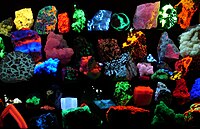
Photo from wikipedia
ABSTRACT Images of laser-induced fluorescence (LIF) of hydroxyl radicals (OH) produced in premixed flames are here analyzed from the perspective of fractal theory applied to flame wrinkling. The results confirm… Click to show full abstract
ABSTRACT Images of laser-induced fluorescence (LIF) of hydroxyl radicals (OH) produced in premixed flames are here analyzed from the perspective of fractal theory applied to flame wrinkling. The results confirm that the signal isosurface showing the best correlation with the position of the maximum fluorescence gradient is in a strong correspondence with the inner layer within which the reference surface of maximum heat release can be found. Nonetheless, fluctuating maximum OH concentration or poor levels of signal-to-noise ratio could lead to a partial failure of either threshold or maximum gradient techniques of front extraction from LIF images. On the other hand, potential deviations from the reference surface can be tolerated provided that the chosen isosurface has a fractal dimension D 2 ranging between 1.10 and 1.26, well below the limit for passive scalars (D 2 = 1.37).
Journal Title: Combustion Science and Technology
Year Published: 2020
Link to full text (if available)
Share on Social Media: Sign Up to like & get
recommendations!